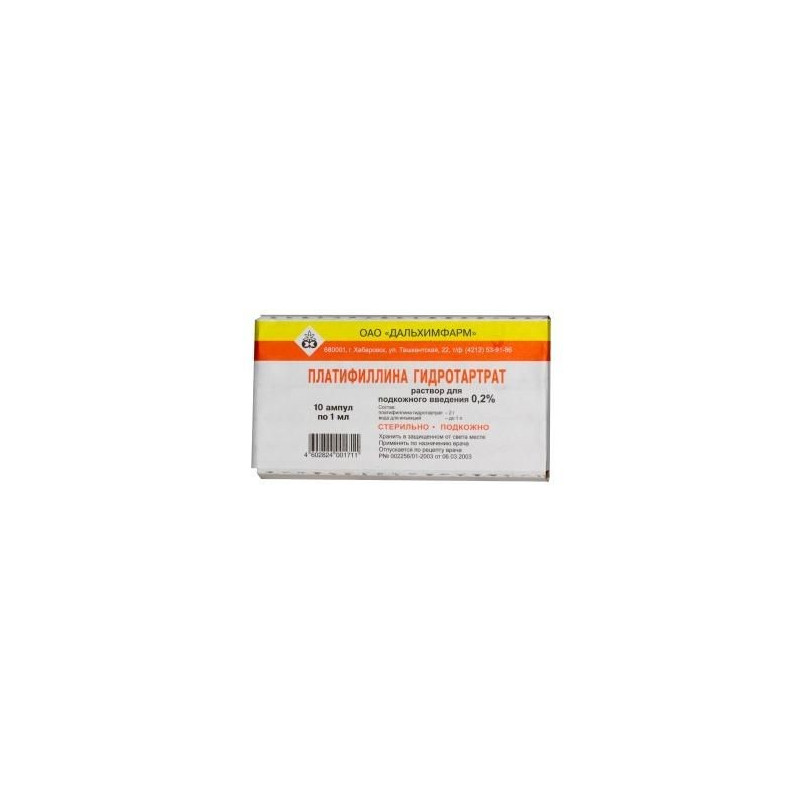



 All payments are encrypted via SSL
All payments are encrypted via SSL
 Full Refund if you haven't received your order
Full Refund if you haven't received your order
Indications for use
Pharmacokinetics
After ingestion is well absorbed from the gastrointestinal tract. Subjected to hydrolysis with the formation of platinum cin and platinecine acid.
Clinical Pharmacology
Blocker of m-cholinergic receptors. Compared with atropine, it has a less pronounced effect on peripheral m-cholinergic receptors (the effect on the smooth muscle cells of the digestive tract and the circular muscle of the iris is 5-10 times weaker than atropine). By blocking m-cholinergic receptors, it interferes with the transmission of nerve impulses from postganglionic cholinergic nerves to the effector organs and tissues (heart, smooth muscle organs, external secretion glands) innervated by them; also inhibits n-cholinergic receptors (much weaker).The holinoblocking effect is most pronounced against the background of the increased tone of the parasympathetic part of the autonomic nervous system or the action of m-holostimulants.
To a lesser extent than atropine, causes tachycardia, especially when used in high doses. Reducing the effect of n.vagus, improves the conductivity of the heart, increases the excitability of the myocardium, increases the minute volume. It has a direct myotropic antispasmodic effect, causes the expansion of small vessels of the skin. In high doses it inhibits the vasomotor center and blocks the sympathetic ganglia, as a result of which the blood vessels dilate and the arterial pressure decreases (mainly with intravenous administration). Weaker atropine inhibits the secretion of endocrine glands; causes a pronounced decrease in smooth muscle tone, amplitude and frequency of peristaltic contractions of the stomach, duodenum, small and large intestine, moderate decrease in the tone of the gallbladder (in persons with biliary hyperkinesia); with hypokinesia - the tone of the gallbladder rises to normal. Causes relaxation of the smooth muscles of the uterus, bladder and urinary tract; exerting a spasmolytic effect, eliminates pain. Relaxes the smooth muscles of the bronchi, caused by an increase in the tone of n.vagus or holostimulyatory, increases the volume of respiration, inhibits the secretion of bronchial glands; reduces sphincter tone.
When instilled into the conjunctival sac and parenteral, it causes pupil dilation due to relaxation of the iris circular muscle. At the same time, intraocular pressure rises and accommodation paralysis (relaxation of the ciliary muscle of the ciliary body) occurs. Compared with atropine, the effect on accommodation is less pronounced and shorter. It stimulates the brain and respiratory center, to a greater extent - the spinal cord (in high doses, convulsions, CNS depression, vasomotor and respiratory centers are possible). Penetrates the BBB.
Use during pregnancy and lactation
There are no data on the safety of use of platifillin during pregnancy and lactation (breastfeeding).
Use caution:
Dry mouth, thirst, intestinal atony.
Decreased blood pressure, tachycardia.
CNS stimulation, dizziness,pupil dilation, accommodation paralysis, headache, photophobia, convulsions, acute psychosis.
Difficulty urinating, urinary retention.
Atelectasis of the lung.
Adverse reactions are most likely with high doses of platifillin.
Interaction
With simultaneous use with Haloperidol in patients with schizophrenia, a decrease in the antipsychotic effect is possible.
Platyfillin is an antagonist of Prozerin.
With simultaneous use increases the duration of the hypnotic action of phenobarbital, sodium etamininal, Magnesium sulfate.
With simultaneous use with other m-holinoblokatorami, as well as drugs,possessing m-holinoblokiruyuschego activity (including amantadine, haloperidol, phenothiazine, MAO inhibitors, tricyclic antidepressants, some antihistamines) increases the risk of side effects.
Morphine enhances the inhibitory effect of platifillin on the cardiovascular system.
With simultaneous use with MAO inhibitors, a positive chrono-and bathmotropic effect is observed; with cardiac glycosides - a positive bathmotropic effect.
For pain associated with smooth muscle spasms, analgesics, sedatives and anxiolytics increase the effect of platifillin, and hypotensive and sedatives for vascular spasms.
Dosage and administration
Applied orally, parenterally (s / c, in / in), rectally, topically in ophthalmology.
The dose depends on the indications, route of administration, age of the patient.
Precautionary measures
It is necessary to refrain from potentially hazardous activities that require increased attention and quickness of psychomotor reactions.
Storage conditions